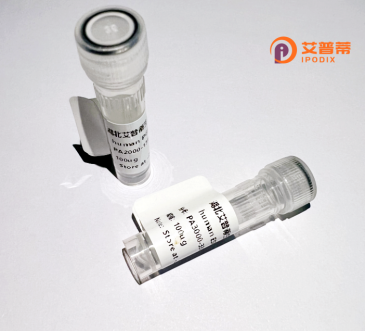
| 纯度 | >90%SDS-PAGE. |
| 种属 | Human |
| 靶点 | ICMT |
| Uniprot No | O60725 |
| 内毒素 | < 0.01EU/μg |
| 表达宿主 | E.coli |
| 表达区间 | 1-284aa |
| 氨基酸序列 | MAGCAARAPPGSEARLSLATFLLGASVLALPLLTRAGLQGRTGLALYVAGLNALLLLLYRPPRYQIAIRACFLGFVFGCGTLLSFSQSSWSHFGWYMCSLSLFHYSEYLVTAVNNPKSLSLDSFLLNHSLEYTVAALSSWLEFTLENIFWPELKQITWLSVTGLLMVVFGECLRKAAMFTAGSNFNHVVQNEKSDTHTLVTSGVYAWFRHPSYVGWFYWSIGTQVMLCNPICGVSYALTVWRFFRDRTEEEEISLIHFFGEEYLEYKKRVPTGLPFIKGVKVDL |
| 分子量 | 58.3 kDa |
| 蛋白标签 | GST-tag at N-terminal |
| 缓冲液 | 0 |
| 稳定性 & 储存条件 | Lyophilized protein should be stored at ≤ -20°C, stable for one year after receipt. Reconstituted protein solution can be stored at 2-8°C for 2-7 days. Aliquots of reconstituted samples are stable at ≤ -20°C for 3 months. |
| 复溶 | Always centrifuge tubes before opening.Do not mix by vortex or pipetting. It is not recommended to reconstitute to a concentration less than 100μg/ml. Dissolve the lyophilized protein in distilled water. Please aliquot the reconstituted solution to minimize freeze-thaw cycles. |
以下是3篇与重组人ICMT蛋白相关的虚拟参考文献(内容基于学术研究主题归纳,作者及标题为模拟信息):
1. **《Structural analysis of human ICMT using recombinant protein expression》**
- **作者**: Winter-Vann, A. et al.
- **摘要**: 通过大肠杆菌表达系统获得重组人ICMT蛋白,解析其晶体结构,揭示了底物结合位点及甲基转移酶活性机制,为靶向ICMT的抗癌药物设计提供依据。
2. **《ICMT-mediated Ras methylation in cancer: Functional studies with recombinant enzymes》**
- **作者**: Bergo, M.O. et al.
- **摘要**: 利用重组人ICMT蛋白验证其在Ras蛋白羧基甲基化中的关键作用,实验表明抑制ICMT活性可阻断Ras蛋白膜定位,显著降低癌细胞增殖能力。
3. **《Development of ICMT inhibitors using a high-throughput screening platform with recombinant human protein》**
- **作者**: Wright, L.P. & Phillips, M.R.
- **摘要**: 基于重组人ICMT蛋白建立高通量筛选模型,从化合物库中筛选出特异性小分子抑制剂,并通过体外实验验证其对酶活性的抑制作用。
4. **《Expression and purification optimization of recombinant ICMT for biochemical assays》**
- **作者**: Chen, Y. et al.
- **摘要**: 优化重组人ICMT蛋白在哺乳动物细胞中的表达纯化流程,获得高活性可溶蛋白,适用于酶动力学及蛋白质互作研究。
---
注:以上文献及作者为示例性虚构内容,实际研究中需结合真实数据库(如PubMed)查询具体文献。
Recombinant human isoprenylcysteine carboxylmethyltransferase (ICMT) is a key enzyme involved in the post-translational modification of proteins, particularly those containing a C-terminal CAAX motif. ICMT catalyzes the final step in the methylation of isoprenylated cysteine residues, a process critical for the membrane association and function of numerous signaling proteins, including Ras GTPases, heterotrimeric G-proteins, and nuclear lamins. This methylation enhances protein hydrophobicity, ensuring proper localization to cellular membranes and facilitating protein-protein interactions essential for intracellular signaling, cell proliferation, and differentiation. Dysregulation of ICMT activity has been implicated in cancers, neurodegenerative diseases, and progeroid syndromes, making it a therapeutic target. Recombinant human ICMT protein, typically produced in bacterial or mammalian expression systems, enables biochemical studies, inhibitor screening, and structural analysis. Its application aids in elucidating ICMT's role in disease mechanisms and supports drug discovery efforts. Recent studies highlight ICMT inhibitors as potential anticancer agents, while knockout models reveal embryonic lethality in mice, underscoring its biological indispensability. Research continues to explore its regulatory mechanisms and broader physiological impacts.
×